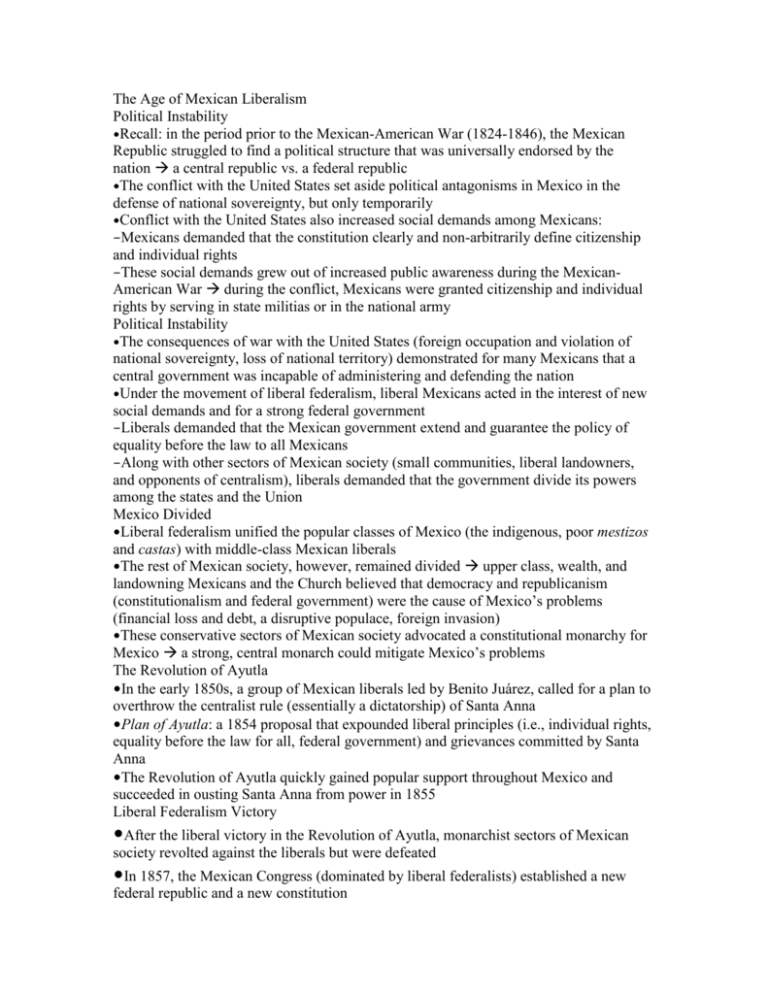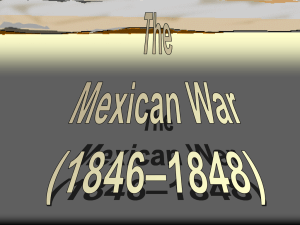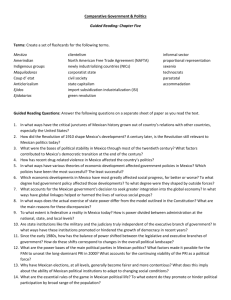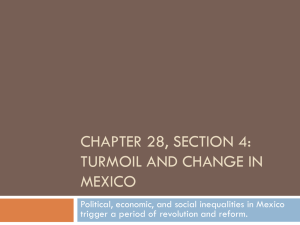The Age of Mexican Liberalism
advertisement

The Age of Mexican Liberalism Political Instability •Recall: in the period prior to the Mexican-American War (1824-1846), the Mexican Republic struggled to find a political structure that was universally endorsed by the nation a central republic vs. a federal republic •The conflict with the United States set aside political antagonisms in Mexico in the defense of national sovereignty, but only temporarily •Conflict with the United States also increased social demands among Mexicans: –Mexicans demanded that the constitution clearly and non-arbitrarily define citizenship and individual rights –These social demands grew out of increased public awareness during the MexicanAmerican War during the conflict, Mexicans were granted citizenship and individual rights by serving in state militias or in the national army Political Instability •The consequences of war with the United States (foreign occupation and violation of national sovereignty, loss of national territory) demonstrated for many Mexicans that a central government was incapable of administering and defending the nation •Under the movement of liberal federalism, liberal Mexicans acted in the interest of new social demands and for a strong federal government –Liberals demanded that the Mexican government extend and guarantee the policy of equality before the law to all Mexicans –Along with other sectors of Mexican society (small communities, liberal landowners, and opponents of centralism), liberals demanded that the government divide its powers among the states and the Union Mexico Divided •Liberal federalism unified the popular classes of Mexico (the indigenous, poor mestizos and castas) with middle-class Mexican liberals •The rest of Mexican society, however, remained divided upper class, wealth, and landowning Mexicans and the Church believed that democracy and republicanism (constitutionalism and federal government) were the cause of Mexico’s problems (financial loss and debt, a disruptive populace, foreign invasion) •These conservative sectors of Mexican society advocated a constitutional monarchy for Mexico a strong, central monarch could mitigate Mexico’s problems The Revolution of Ayutla •In the early 1850s, a group of Mexican liberals led by Benito Juárez, called for a plan to overthrow the centralist rule (essentially a dictatorship) of Santa Anna •Plan of Ayutla: a 1854 proposal that expounded liberal principles (i.e., individual rights, equality before the law for all, federal government) and grievances committed by Santa Anna •The Revolution of Ayutla quickly gained popular support throughout Mexico and succeeded in ousting Santa Anna from power in 1855 Liberal Federalism Victory •After the liberal victory in the Revolution of Ayutla, monarchist sectors of Mexican society revolted against the liberals but were defeated •In 1857, the Mexican Congress (dominated by liberal federalists) established a new federal republic and a new constitution The Constitution of 1857 •The Constitution of 1857 incorporated many principles of liberal federalism: –The constitution clearly defined individual rights (i.e., freedom of speech, freedom to education, freedom of the press, equality before the law, protection of property, the right to bear arms, the right to due process, etc.) –The constitution did not specify Roman Catholicism as the sole religion of the state the constitution implicitly allowed for religious plurality, toleration and, thus, freedom of religion –The constitution also incorporated what are known as the Reform or “Juárez” laws legislation that abolished military and Church privileges and immunities –The Reform or “Juárez” laws also stipulated that non-ecclesiastic property owned by the Church and non-military buildings owned by state or national militia would be put up for auction to the Mexican public Conservative Reaction to the Constitution of 1857 •The Constitution of 1857 alienated the Church and the military in Mexico as the constitution eliminated the rights, privileges, and property of these institutions •The Church threatened excommunication to any and all Mexicans who accepted and abided to the constitution (as well as those who purchased former Church property) the Pope, Pius IX, supported the Church in Mexico, refuting the validity of the constitution (the beginning of church-state antagonisms) Civil War: The War of Reform •The Constitution of 1857 divided Mexican society among liberals and conservatives profound division of Mexican society resulted in civil war •Plan de Tacubaya: 1858 conservative plan that sought to re-establish central government and sought to abolish the 1857 Constitution •Conservatives quickly assumed control of Mexico City and forced the liberals out of the capital conservatives named their own president •Liberals, led by Benito Juárez, fled north to Querétaro at Querétaro, Mexican liberals declared Juárez president Civil War: The War of Reform •The civil war lasted three years in Mexico (1858-1860) •Although the liberals eventually established a new capital at Veracruz, they struggled mightily during the first two years of the conflict conservatives had support of the national army (better trained, equipped, and better military leadership) •Civil war caused devastation throughout Mexico as soldiers from both sides caused massive damage to civilians and public buildings the (conservative or liberal) “cause” justified the soldiers’ actions Civil War: The War of Reform •By 1860, liberals had gained the upper hand –Conservative forces disputed amongst each other –The emergence of two excellent liberal commanders: Jesús González Ortega and Ignacio Zaragoza •In December of 1860, liberal forces defeated the conservative army and captured Mexico City victory of liberal federalism Benito Juárez •Once the liberals regained control of the government, presidential elections were held in March 1861 and Juárez was elected president •Juárez was a Zapotec Indian born in 1806 in the state of Oaxaca •Until the age of 12, Juárez was illiterate and did not speak Spanish, only spoke the indigenous language of Zapotec •After age 12, he traveled to the capital of Oaxaca (Oaxaca City) and was educated in a seminary school •Instead of pursuing a religious life, Juárez found his calling in politics; he attended and graduated from law school in Oaxaca and soon became a skillful politician Benito Juárez •As president, Juárez remained true to the ideals of the constitution, particularly the separation between state and Church in fact, the secularization of the state increased under Juárez, eliciting positive approval from the Mexican public •Juárez’s dedication to upholding the ideals and principles of liberal federalism and the 1857 Constitution strengthened opposition among Mexican conservatives, especially the Church Foreign Intervention •At the same time, liberalism was spreading in Europe and the Vatican equated liberalism with anticlericalism the goals of opposing liberalism and preserving Church power united both Mexican and European conservatives (an alliance was created between Mexican and European conservatives) •The civil war in Mexico left the government nearly bankrupt •The Mexican state, attempting to rebuild and prevent further loss to the Mexican economy, failed to pay international loans European lenders, particularly England, France, and Spain, demanded debt payment •Mexico’s failure to pay its international debt resulted in foreign occupation: –On Oct. 31, 1861, England, France, and Spain agreed to occupy the eastern coast of Mexico in order to collect their payment Foreign Invasion •In December 1861, England, France, and Spain invaded Mexico at the port of Veracruz and marched inland •In addition to collecting finances, the French Emperor Napoleon III desired to establish French hegemony in Mexico Napoleon III wanted to establish a French Empire in Mexico •After learning of France’s intentions, both England and Spain pulled out of Mexico the French continued its march towards Mexico City The French Intervention •On May 5, 1862, French forces reached the city of Puebla –The city was defended by Mexican forces led by two generals, Ignacio Zaragoza and Porfirio Díaz –The Mexican forces victorious in la batalla de Puebla (the battle of Puebla) and drove the French out –After the defeat, however, France immediately sent 30K troops to Mexico the French took Puebla and marched towards Mexico City •Juárez left the capital and moved the Mexican government north The French Empire in Mexico June 12, 1862 the French Empire was officially declared in Mexico the second empire in Mexico greatly pleased Mexican conservatives •Napoleon III named the Austrian archduke Maximilian of Hapsburg as the Emperor of Mexico The French Empire •As emperor, Maximilian, and his wife Charlotte (Carlota in Spanish), held Mexico in high regard: “I [Maximilian] found the country [Mexico] far better than I expected… and the people far more advanced than supposed at home. Our reception was cordial and sincere, free from all pretence and from that nauseating official servility which one very often finds in Europe on such occasions. The country is very beautiful, tropically luxuriant in the coast lands… The so-called entertainments of Europe, such as evening receptions, the gossip of teaparties, etc., etc., of hideous memories, are quite unknown here, and we shall take good care not to introduce them.” (Maximilian writing to his younger brother about Mexico) The French Empire •During their reign in Mexico, the French monarchs Maximilian and Carlota resided in the Chapultepec Castle •Both Maximilian and Carlota made a concerted effort to connect with Mexico and its people they traveled throughout the country and interacted with the population •In honor of his wife, Maximilian order the construction of an extensive avenue in Mexico City, called La Calzada de la Emperatriz Juárez and the Liberals •After the French entered Mexico City in 1862, Juárez moved the Mexican government north, initially to San Luis Potosí and then to the city of Paso del Norte in Chihuahua (now known as Ciudad Juárez) •From the north of Mexico, liberal forces engaged the French Empire in guerrilla skirmishes liberals were able to present effective resistance to the French Empire, but they remained restricted to the north •After 1865, the French Empire began to lose its grip on Mexico as Maximilian supported and implemented liberal legislation that alienated conservatives in Mexico •Juárez realized the vulnerability of the empire and searched for support Liberal Mexico and the United States •When the French initially invaded Mexico in 1862, Juárez appealed to president Abraham Lincoln for United States support against France •Unfortunately, Lincoln could not extend U.S. support to Mexico as the American Civil War erupted in 1861 Lincoln’s government, however, verbally supported Juárez’s liberal government and refused to recognize the legitimacy of the French Empire in Mexico •In 1866, after the conclusion of the American Civil War, the U.S. government gave its support to Juárez and the liberals the U.S. allowed Juárez entry into the U.S. to purchase arms and to recruit troops; the U.S. also sent 50K soldiers to the Texas border at the Rio Grande Another Liberal Victory •The support of the U.S. convinced French Emperor Napoleon III to withdraw his troops from Mexico Maximilian, however, refused to renounce his imperial throne •On 1867, Maximilian led a final assault on Juárez’s liberal forces at Querétaro Maximilian defeated and captured by the liberals •Maximilian was tried in a court martial and was sentenced to the death penalty •On June 19, 1867, Maximilian was executed by firing squad on the Hill of the Bells in Querétaro restoration of the Mexican Republic •In







